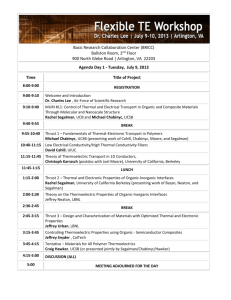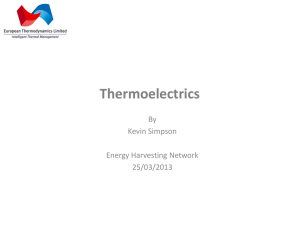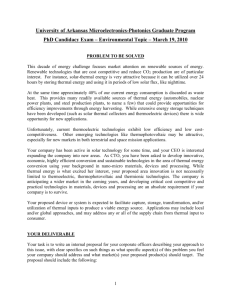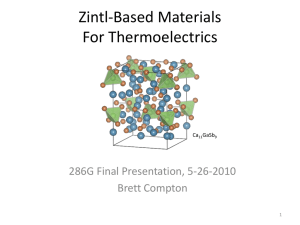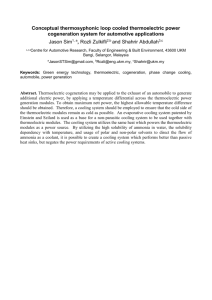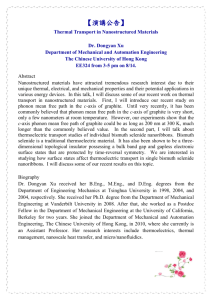Paper number 3 - University of Pittsburgh
advertisement
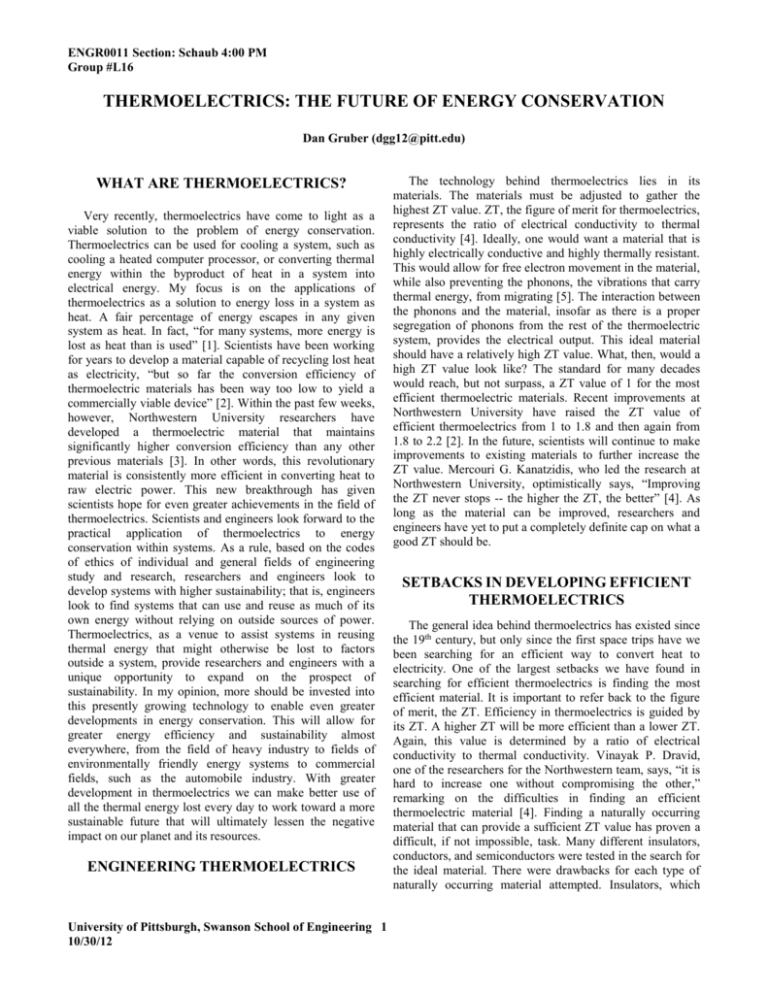
ENGR0011 Section: Schaub 4:00 PM Group #L16 THERMOELECTRICS: THE FUTURE OF ENERGY CONSERVATION Dan Gruber (dgg12@pitt.edu) WHAT ARE THERMOELECTRICS? Very recently, thermoelectrics have come to light as a viable solution to the problem of energy conservation. Thermoelectrics can be used for cooling a system, such as cooling a heated computer processor, or converting thermal energy within the byproduct of heat in a system into electrical energy. My focus is on the applications of thermoelectrics as a solution to energy loss in a system as heat. A fair percentage of energy escapes in any given system as heat. In fact, “for many systems, more energy is lost as heat than is used” [1]. Scientists have been working for years to develop a material capable of recycling lost heat as electricity, “but so far the conversion efficiency of thermoelectric materials has been way too low to yield a commercially viable device” [2]. Within the past few weeks, however, Northwestern University researchers have developed a thermoelectric material that maintains significantly higher conversion efficiency than any other previous materials [3]. In other words, this revolutionary material is consistently more efficient in converting heat to raw electric power. This new breakthrough has given scientists hope for even greater achievements in the field of thermoelectrics. Scientists and engineers look forward to the practical application of thermoelectrics to energy conservation within systems. As a rule, based on the codes of ethics of individual and general fields of engineering study and research, researchers and engineers look to develop systems with higher sustainability; that is, engineers look to find systems that can use and reuse as much of its own energy without relying on outside sources of power. Thermoelectrics, as a venue to assist systems in reusing thermal energy that might otherwise be lost to factors outside a system, provide researchers and engineers with a unique opportunity to expand on the prospect of sustainability. In my opinion, more should be invested into this presently growing technology to enable even greater developments in energy conservation. This will allow for greater energy efficiency and sustainability almost everywhere, from the field of heavy industry to fields of environmentally friendly energy systems to commercial fields, such as the automobile industry. With greater development in thermoelectrics we can make better use of all the thermal energy lost every day to work toward a more sustainable future that will ultimately lessen the negative impact on our planet and its resources. ENGINEERING THERMOELECTRICS University of Pittsburgh, Swanson School of Engineering 1 10/30/12 The technology behind thermoelectrics lies in its materials. The materials must be adjusted to gather the highest ZT value. ZT, the figure of merit for thermoelectrics, represents the ratio of electrical conductivity to thermal conductivity [4]. Ideally, one would want a material that is highly electrically conductive and highly thermally resistant. This would allow for free electron movement in the material, while also preventing the phonons, the vibrations that carry thermal energy, from migrating [5]. The interaction between the phonons and the material, insofar as there is a proper segregation of phonons from the rest of the thermoelectric system, provides the electrical output. This ideal material should have a relatively high ZT value. What, then, would a high ZT value look like? The standard for many decades would reach, but not surpass, a ZT value of 1 for the most efficient thermoelectric materials. Recent improvements at Northwestern University have raised the ZT value of efficient thermoelectrics from 1 to 1.8 and then again from 1.8 to 2.2 [2]. In the future, scientists will continue to make improvements to existing materials to further increase the ZT value. Mercouri G. Kanatzidis, who led the research at Northwestern University, optimistically says, “Improving the ZT never stops -- the higher the ZT, the better” [4]. As long as the material can be improved, researchers and engineers have yet to put a completely definite cap on what a good ZT should be. SETBACKS IN DEVELOPING EFFICIENT THERMOELECTRICS The general idea behind thermoelectrics has existed since the 19th century, but only since the first space trips have we been searching for an efficient way to convert heat to electricity. One of the largest setbacks we have found in searching for efficient thermoelectrics is finding the most efficient material. It is important to refer back to the figure of merit, the ZT. Efficiency in thermoelectrics is guided by its ZT. A higher ZT will be more efficient than a lower ZT. Again, this value is determined by a ratio of electrical conductivity to thermal conductivity. Vinayak P. Dravid, one of the researchers for the Northwestern team, says, “it is hard to increase one without compromising the other,” remarking on the difficulties in finding an efficient thermoelectric material [4]. Finding a naturally occurring material that can provide a sufficient ZT value has proven a difficult, if not impossible, task. Many different insulators, conductors, and semiconductors were tested in the search for the ideal material. There were drawbacks for each type of naturally occurring material attempted. Insulators, which Dan Gruber have both a low electrical and thermal conductivity, and conductors, which have a high electrical and thermal conductivity, proved to be too weak of thermoelectrics for any legitimate use. In either of these materials, according to the ratio of electrical to thermal conductivity, the ZT would be too low to be efficient enough for use. Any naturally occurring semiconductor also failed to meet sufficient efficiency standards. However, modifying a semiconductor at the atomic level allowed for a relatively high ZT of 1, considering that unmodified materials could not reach this value prior [2]. This seemed to be the best ZT number. After decades, though, this number stalled at 1 for lack of better material. However, more recent advances have managed to bring that number up significantly. We now know that a ZT of 1 was only just the beginning. lattices, researchers discovered a far more efficient material that can be used to allow the free flow of electrons while holding back the flow of phonons. Originally, thermoelectric materials could only regain about 5-7 percent of lost thermal energy [5]. With these more recent breakthroughs, researchers predict 15-20 percent efficiency [1]. More remarkable than these numbers, this method of manipulating the scattering of phonons in the material used, lead telluride, can be used by any other thermoelectric material. This means that the method used by these researchers and engineers to create this efficient material can be replicated on virtually any compatible semiconductive material. These researchers have done more than simply create a monopoly for lead telluride to work as the only thermoelectric material. They’ve created a system whereby any like material can be manipulated in a similar manner. A cheaper material, for instance, of similar properties to lead telluride, could be implemented to create a sufficiently efficient thermoelectric material that would cost less for the public. This versatility of materials, along with a general development of the technology over time, will allow for even greater values of efficiency or make thermoelectrics more economically viable to the public [1]. “‘I am sure that the authors’ findings will trigger exponential progress in the performance of thermoelectric materials,’ writes [Tom Nilges, a chemistry professor at the Technische Universität München in Garching, Germany]” [2]. Researchers are now confident that they can reach ZTs of 2.5 or 3, which means the efficiency of thermoelectric materials is predicted rise as well. ADVANCES IN DEVELOPING THERMOELECTRIC MATERIALS Within the past decade, scientists and researchers managed to develop materials that would provide a higher ZT number than 1. Scientists had already known how to modify the thermal conductivity of the material at an atomic scale, by replacing certain atoms along the thermoelectric material’s crystal lattice, to find a ZT of about 1 or 1.1 [2]. In doing this, scientists disrupted only the phonons, the thermal vibrations, of a short wavelength. In 2004, researchers and engineers at Northwestern University found that by adjusting the material at the nanometer-scale, by rearranging the crystal lattices, they could create a ZT of up to about 1.7 in the test materials [2]. Their method, which was really a combination of methods, disrupted the phonons of short and medium wavelength. Very recently, however, scientists and researchers at Northwestern University have managed to obtain a ZT of 2.2. The method used compounded the previous methods of material configuration at smaller scales with another layer of configuration at the mesoscale, at about the scale of 1 micrometer. (See figure below [2]) “In particular, the researchers improved the longwavelength scattering of phonons by controlling and tailoring the mesoscale architecture of the nanostructured thermoelectric materials” [3]. By rearranging the larger structure of WHY ARE THERMOELECTRICS IMPORTANT? As much as 40 percent of petrol energy is lost to heat waste. Two thirds of coal energy is lost to the escape of thermal energy [5]. So much energy is continuously lost from these systems. Systems with lower energy efficiency and sustainability must rely more heavily on outside sources of power. Such reliance on other power sources puts undue amounts of strain on the environment around them. As an engineer, I must seek the path that creates sustainable systems that lessen the dependence and burden on the environment around me. The National Society of Professional Engineers’ (NSPF) code of ethics has something to say about the protection of the environment for the uses of the future. The NSPF says, “engineers are encouraged to adhere to the principles of sustainable development in order to protect the environment for future generations” [6]. Engineers have a duty not only to themselves but to the environment around them. The American Institute of Chemical Engineers (AIChE) and the Institute of Electrical and Electronics Engineers (IEEE) both have a similar directive in their codes. The AIChE code of ethics states that its engineers should strive to “protect the 2 Dan Gruber environment in performance of their professional duties” [7]; The code of ethics for the IEEE advises its engineers to watch and warn for harmful environmental effects [8]. Engineers hold the well-being and protection of the environment to a high degree. Thermoelectrics are important because they give scientists and engineers the opportunity to explore sustainable energy systems that will help protect the environment for many years. In general, there are two ways to overcome the loss of energy and the increased strain on the environment: create better systems where heat is not a significant by-product or has less opportunity to escape or find a way to regain energy lost as heat escapes. Although both solutions would assist an engineer’s goal to create a more energy sustainable world, given the more recent advancements and breakthroughs in thermoelectric materials, the more viable solution now is the latter, to find a way to regain most of the thermal energy released as a part of the system. The most efficient thermoelectric materials can convert up to 20 percent of surrounding thermal energy into electrical energy. Applied to the automobile industry, thermoelectrics can increase the efficiency of the energy use and consumption of cars up to 8 percent. Higher energy efficiency would lighten the car’s dependence on gas and could create more fuel efficient vehicles because of that. Thermoelectrics applied to cars would have clear benefits, as you would see in the gas mileage increasing. Given how successful scientists and researchers have been so far, and how confident they are that they will continue to make progress, it is really only a matter of time before thermoelectrics become commercially available and commercially viable. These thermoelectric materials can also be used to retrieve the waste heat energy lost from coal energy. In that case, where two thirds of the energy is lost, thermoelectrics could be even more helpful in retrieving and converting larger quantifications of energy. Thermoelectrics could have a large impact on the world of already sustainable energy solutions. Solar panels, as of now, “only metabolise the photons from the high-frequency part of the electromagnetic spectrum, meaning most of the sun's rays are lost as waste heat” [5]. The addition of thermoelectric materials to the general make and composition of solar panels would grant these eco-friendly devices the ability to absorb a much larger spectrum of the Sun’s energy. “Use thermoelectric materials to harness the entire spectrum and your solar panel will get whopping good efficiencies” [5]. Thermoelectrics would have the benefit of being able to absorb some of the energy it previously could not receive. The commercial benefit would be that the energy necessary to power a house or other commercial items would be provided now in a larger part by the thermoelectrically supported solar panel. There would be a slightly reduced energy bill if solar panels were applied to a house as well. Thermoelectrics are important and interesting to me for these and a few other reasons. I wish to be an electrical engineer. I see thermoelectrics as a fantastic opportunity to work toward a more complete sustainable system of energy conservation. I would be more than overjoyed if I were to see such a feat progress in my lifetime. More than that, if I could have a hand in its development, it would be a very personal thing for me to work with. We have before us a key opportunity to decrease our environmental footprint, and I think it’s really unique to be knowledgeable about it or be a part of it. Thermoelectrics are not new, but I am glad to look upon thermoelectrics as we discover new ways to utilize it for better and more efficient energy. I think there is value as well in discussing the prospect of thermoelectrics within a paper format such as this one. This assignment has allowed me to have some experience now with a real, current engineering issue. It has given me the opportunity to find a subject that I can be interested in by personalizing it for me. This has allowed me to self-motivate myself in this project, so that I could get the greatest experience out of this [9]. I have taken a personal interest in this topic that I have chosen and I have absorbed so much of the information that I have researched and reviewed. As a result of this assignment, too, I have discovered and studied the different codes of ethics for engineers. This has also been really important in this assignment, as now I am more familiar with these codes that all engineers should be knowledgeable of. Overall, this assignment has opened many doors for me to peer through in the world of engineering and that has been a tremendous benefit. REALIZATION OF THE POTENTIAL OF THERMOELECTRICS In my opinion, it is worth the effort to focus on thermoelectrics. The study and utilization of thermoelectrics has only just recently exited a field that had previously been in a period of decades of stagnation. The technology is here to look into and develop thermoelectrics more fully. There have already been tremendous breakthroughs in this subject. With a little more push we will certainly see even greater strides. Certainly we can one day see thermoelectrics becom commercially viable and helpful. Once we can apply what we know about thermoelectrics to the world around us, with cars and industrial factories and sustainable energy operations, we can make everything a little bit more energy efficient. If we become more energy efficient we can lower our dependence on any energy, foreign or domestic. With the right amount of focus and attention on thermoelectrics, we are one step closer to a more energy efficient and selfsustaining world. We come one step closer, too, to a world that is built for the prosperity of the environment for our future generations. In developing thermoelectrics, we can really say that we are progressing toward a healthier and happier world that can take care of itself. REFERENCES 3 Dan Gruber [1] J. Pitchford. (September 27, 2012). “Record Breaking Thermoelectric Material Developed.” Overclockers Club. (Online Article). http://www.overclockersclub.com/news/32755/ [2] W. Jones. (September 2012). “Waste Heat to Electricity Breakthrough.” IEEE Spectrum. (Online article). http://spectrum.ieee.org/semiconductors/materials/wasteheat-to-electricity-breakthrough [3] M. Fellman. (September 19, 2012). “World Record Holder: Thermoelectric Material is the Best at Converting Heat Waste to Electricity.” Northwestern University. (Online article). http://www.northwestern.edu/newscenter/stories/2012/09/wo rld-record-holder-.html [4] (September 24, 2012). “Thermoelectric Material is World’s Best.” Energy Harvesting Journal. (Online article). http://www.energyharvestingjournal.com/articles/thermoelec tric-material-is-worlds-best-00004751.asp?sessionid=1 [5] S. Adee. (September 26, 2012). “Thermoelectric Efficiency Boost is Good News for Solar.” One Per Cent. (Online blog). http://www.newscientist.com/blogs/onepercent/2012/09/ther moelectric-efficiency-boos.html [6] (2012). “NSPE Code of Ethics for Engineers.” NSPE. (Online Website). http://www.nspe.org/Ethics/CodeofEthics/index.html [7] “Code of Ethics.”AIChE. (Online Website). http://www.aiche.org/about/code-ethics [8] (2012). “IEEE Code of Ethics.”IEEE. (Online Website). http://www.ieee.org/about/corporate/governance/p7-8.html [9] D. Gillet. (April 14-16, 2010). “Personal Learning Environments in a Global Higher Engineering Education.” IEEE Xplore. (Online Article). http://ieeexplore.ieee.org/xpls/abs_all.jsp?arnumber=549248 3&tag=1 ACKNOWLEDGMENTS I would like to thank Rick Schaub for inspiring me every Tuesday and Thursday to work hard and be the best engineering student that I can be. I would also like to thank Janine Carlock for providing terrific commentary and suggestions for my second writing assignment. 4
